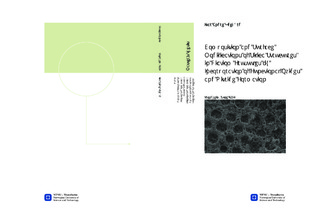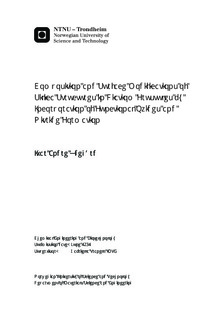| dc.contributor.advisor | Tranell, Gabriella | nb_NO |
| dc.contributor.author | Ødegård, Ivar Andre | nb_NO |
| dc.date.accessioned | 2014-12-19T13:26:45Z | |
| dc.date.available | 2014-12-19T13:26:45Z | |
| dc.date.created | 2012-11-10 | nb_NO |
| dc.date.issued | 2012 | nb_NO |
| dc.identifier | 566964 | nb_NO |
| dc.identifier | ntnudaim:8162 | nb_NO |
| dc.identifier.uri | http://hdl.handle.net/11250/249150 | |
| dc.description.abstract | Renewable energy production featuring silicon photovoltaic solar cells are of considerable interest to reduce pollution and related environmental changes. Improvements in efficiency along with reductions in cost are key elements to large scale implementation of this technology. Some suggested and attempted methods of improvements that deserves mentioning are: modifying the energy of incident light to better suit the existing band gap along with reduction in losses by applying surface texturing and nitride coatings. Looking to nature for inspiration reveals diatoms and their frustules having pore structures displaying excellent light harvesting abilities. Thus an implementation of such structural features with regards to solar cell improvements would be highly desirable. This thesis was aimed at performing modifications of diatom frustules surfaces by deposition of oxides known to possess properties of up and down-conversion of light as well as attempting to convert diatom frustules to silicon nitride replicas. Coating frustules with oxides possessing properties of up and down-conversion of light combines light harvesting properties of frustules with spectral modifications of incident light. This offers possibilities of solar cell improvements upon implementation. Nitriding of diatom frustules preserves structural features of the frustules and offers increased mechanical, chemical, thermal and anti-reflecting properties for possible solar cell use. Diatom frustules of the species Coscinodiscus wailesii and Coscinodiscus sp. were utilized in all experimental work during this thesis. An initial temperature exposure experiment was performed at temperatures ranging from 400oC-1200oC with increments of 200oC, to gage thermal response of the frustules. In another set of experiments diatom frustules were subjected to one, two and four dip coatings in one of two different precursor solutions. One solution consisted of erbium and yttrium chloride dissolved in a mixture of ethylene glycol and acetonitrile while the other solution consisted of manganese and zinc chloride dissolved in ethylene glycol and acetonitrile. Post dip coating, frustules were annealed at 800oC in normal atmosphere, decomposing chloride precursors to corresponding oxides. Nitriding of frustules was attempted by simultaneous metallothermic reduction in a purpose built reactor vessel where necessary nitrogen was supplied in the form of ammonia at 650oC and 800oC. Ammonia was generated by thermal decomposition of ammonium chloride mixed with calcium oxide. Post experiments, frustules were characterized by use of scanning electron microscope (SEM) featuring energy dispersive x-ray spectrometer (EDS), fluorescence microscopy, photoluminescence spectroscopy and Raman spectroscopy. Frustules in the temperature exposure experiment were found to display small changes to the pores at 600oC. At 800oC the changes were more severe and the changes were found to increase with increasing temperature until complete destruction of the pores along with visible external changes took place at 1200oC. For the coating experiments, no photoluminescent properties were found to exist for frustules coated once or twice. Frustules coated four times were found to display photoluminescent behavior for both types of coatings. Frustules subjected to four coatings with Zn/Mn solution were found to display more temperature related changes in the pores as compared to frustules coated four times with Y/Er solution. Frustules coated with Zn/Mn solution, were found to be contaminated by elevated levels of tin, possibly influencing both thermal and photoluminescent properties. Frustules subjected to simultaneous metallothermic reduction and nitriding at 650oC were found to suffer low conversion and thus only superficial nitride formation. Frustules nitrided at 800oC were found to display higher conversion to silicon nitride. The formed nitride was determined to be β-silicon nitride by Raman spectroscopy. The frustules were also found to contain elevated levels of reduced silicon, for the frustules nitrided at 800oC, this silicon was found to be a mixture of amorphous and nanocrystalline. The nanocrystalline silicon was found to have a crystalline size of ~2.2 nm. | nb_NO |
| dc.language | eng | nb_NO |
| dc.publisher | Institutt for materialteknologi | nb_NO |
| dc.subject | ntnudaim:8162 | no_NO |
| dc.subject | MIKJ Industriell kjemi og bioteknologi | no_NO |
| dc.subject | Materialer for energiteknologi | no_NO |
| dc.title | Composition and Surface Modifications of Silica Structures in Diatiom Frustules by Incorporation of Functional Oxides and Nitride Formation | nb_NO |
| dc.type | Master thesis | nb_NO |
| dc.source.pagenumber | 166 | nb_NO |
| dc.contributor.department | Norges teknisk-naturvitenskapelige universitet, Fakultet for naturvitenskap og teknologi, Institutt for materialteknologi | nb_NO |

